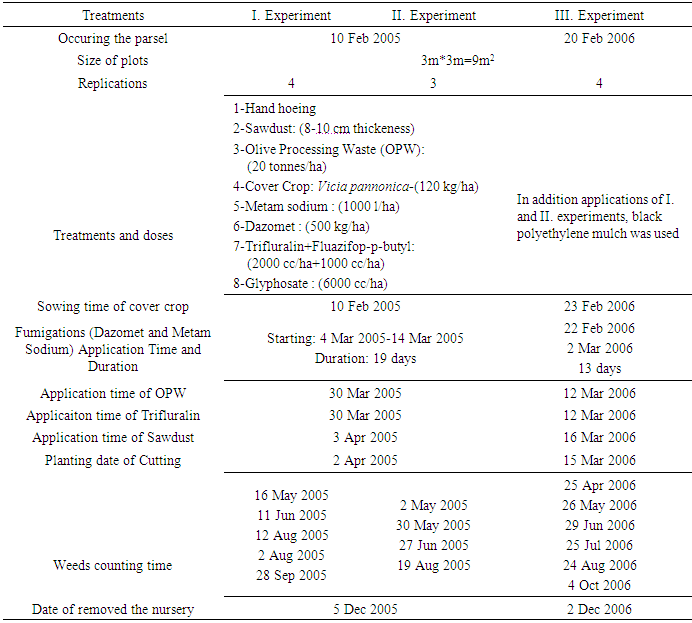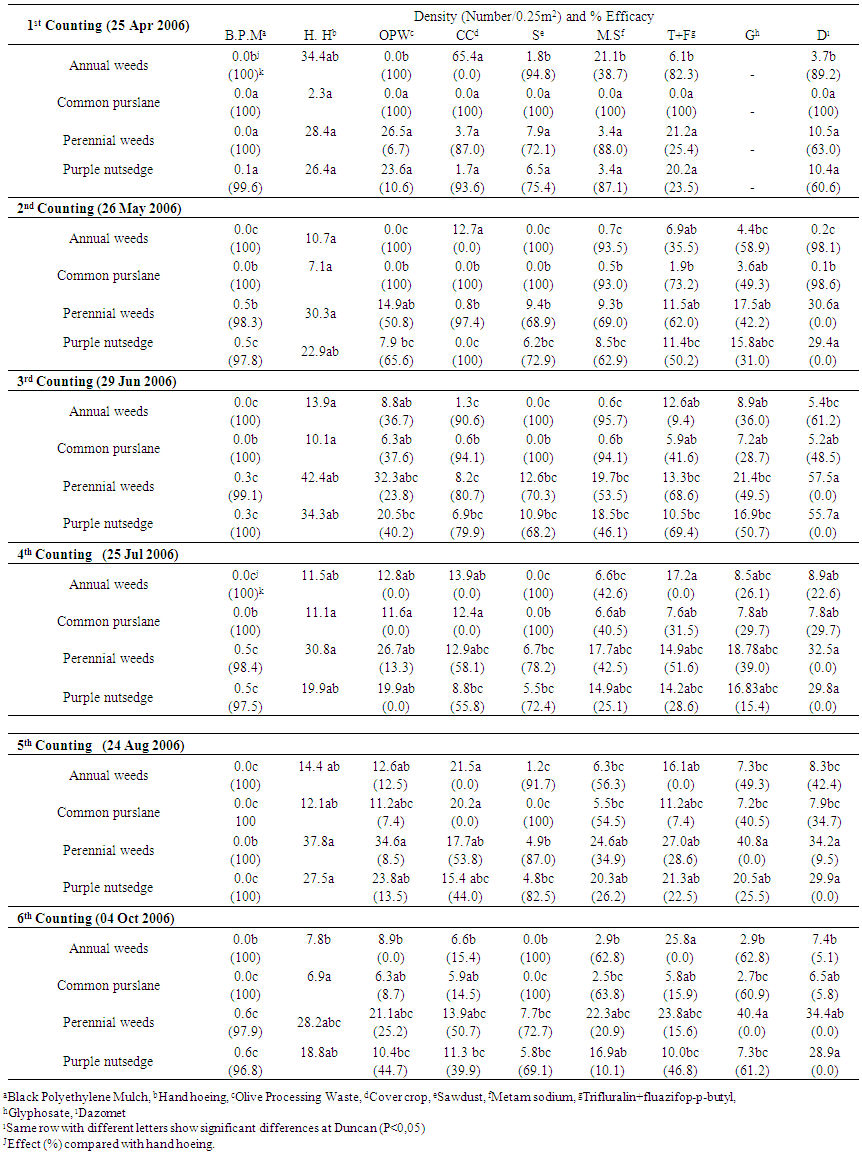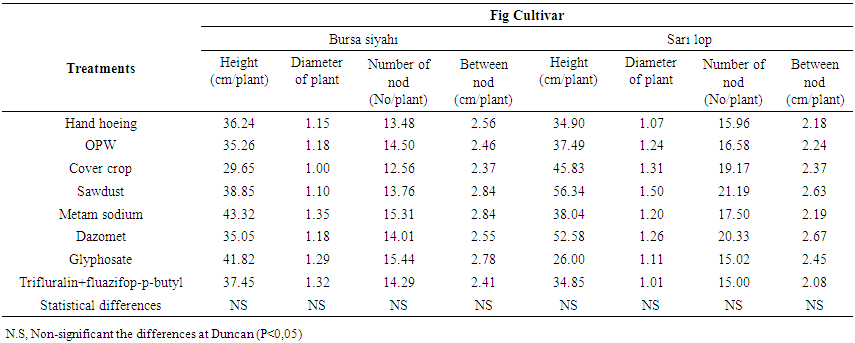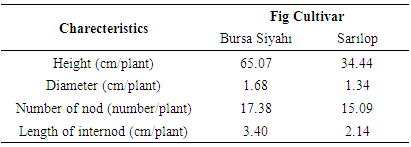-
Paper Information
- Previous Paper
- Paper Submission
-
Journal Information
- About This Journal
- Editorial Board
- Current Issue
- Archive
- Author Guidelines
- Contact Us
International Journal of Agriculture and Forestry
p-ISSN: 2165-882X e-ISSN: 2165-8846
2016; 6(4): 152-160
doi:10.5923/j.ijaf.20160604.03

An Evaluation of the Effectiveness of Different Methods for Weeds in Fig Nurseries
1Uşak University, Agriculture and Natural Sciences Faculty, Department of Plant Protection, Uşak, Turkey
2Adnan Menderes University, Faculty of Agriculture, Department of Plant Protection, Aydın, Turkey
Correspondence to: Derya Öğüt Yavuz, Uşak University, Agriculture and Natural Sciences Faculty, Department of Plant Protection, Uşak, Turkey.
| Email: |  |
Copyright © 2016 Scientific & Academic Publishing. All Rights Reserved.
This work is licensed under the Creative Commons Attribution International License (CC BY).
http://creativecommons.org/licenses/by/4.0/

The experiments were carried out at the Research and Application Farm in the Agricultural Faculty of Adnan Menderes University and was performed three times, in two locations in 2005 and once in 2006. Conducted according to a randomised complete block design and the plots were situated in an area of 9 m-2 (3 m x 3 m). Evaluation of pre-planting applications applied to the soil were: olive processing waste (OPW) (20 tons hectare-1), metham sodium 500 kg a.i. hectare-1, dazomet (485 kg a.i hectare-1), Vicia pannonica (Hungarian vetch) (120 kg hectare-1) as a cover crop. Post-planting applications applied after the fig nurseries had been planted were: glyphosate (2880 g a.i hectare-1), sawdust (thickness of 8-10 cm), black polyethylene mulch, fluazifop-p-butyl (150 g a.i hectare-1) after trifluralin (960 g a.i hectare-1) and hand-hoed plots served as control plots. As a results, sawdust was reduced the density of annual weeds, especially common purslane.The application of OPW was been usable only annual weeds, especially common purslane; it was found that its effectiveness lasts for three months after it has been incorporated into the soil.Metham sodium and dazomet were also found to be effective on annual weeds.In all the experiments, there was neither a harmful nor a beneficial effect of applications on the fig nursery plants themselves.
Keywords: Weed control, Fig nursery, Fumigant
Cite this paper: Derya Öğüt Yavuz, Özhan Boz, An Evaluation of the Effectiveness of Different Methods for Weeds in Fig Nurseries, International Journal of Agriculture and Forestry, Vol. 6 No. 4, 2016, pp. 152-160. doi: 10.5923/j.ijaf.20160604.03.
1. Introduction
- The fig (Ficus carica L.) is a Ficus species from the Moracae family of the Urticales class. In nursery gardens, weed management is carried out by applying methyl bromide to the soil before the figs are planted, applying herbicide, and hoe-cropping 3-10 times, until the figs are ready to be harvest. However, some of these methods are expensive and harmful to roots of the trees and restrict growth. In view of the fact that methyl bromide banned in Turkey by the end of 2008, the necessity of using different methods is an urgent requirement. One alternative method is mulching, which involves covering the soil surface with organic and inorganic materials, which both prevents loss of moisture and stops the penetration of light, thus inhibiting the emergence of many weeds. To this end, successful weed management could be effected using various organic and inorganic mulches such as black polyethylene, straw, sawdust, nutshell, perlite, oyster shell, and pumice and crumb rubber. [32]. Whatever material is used, it must be thick enough to prevent light from penetrating, and it must also protect the structure of the soil [32], [12], [39]. Many researchers have stated that mulch applications lead to yield increases in both annual and perennial crops, and these yield increases are achieved through the reduction of weed competition with the roots, the increase in nutrition uptake, and the amount of water available in the soil [36], [25], [2], [34]. The dried form of Olive Processing waste (OPW) will be referred to as ‘solid OPW’ in this paper. As OPW is rich in organic substances and nutrients such as phosphorus, potassium and magnesium, its usefulness in agriculture as a fertilizer has been investigated in some studies [19], [31]. There are two ways of using a cover crop: one is its incorporation into the soil; the other is growing the cover crop alongside the cultivated plant [35]. Metham sodium is a potential alternative to methyl bromide fumigation. Its strength makes it a strong candidate as a fumigant for many crops [10]. It has been registered for use in the control of a wide array of soil-borne pests. It can be used to control weeds, nematodes, and soil diseases. The other fumigant Dazomet, which can be applied to soil before planting, is effective on some emergent weeds, nematodes, soil borne fungi and insects [10]. A comprehensive study on weed management in nursery gardens has not yet been conducted in Turkey. Therefore this study represents a comprehensive investigation into these methods- hoeing, olive processing waste, sawdust, one of the cover crops (Vicia pannonica), the soil fumigants such as metham sodium and dazomet, and the herbicides trifluralin in conjunction with fluazifop-p-butyl, and glyphosate for control against these weeds.
2. Materials and Methods
- The experiments were carried out at the Research and Application Farm of the Agricultural Facility at Adnan Menderes University in Aydın Provinces of Western Turkey in 2005-2006. The experiments were designed according to randomized complete block design (Table 1). Before the experiment, the field was irrigated and, when the humidity level was suitable, the soil was tilled and the surface was levelled using a disk harrow; then the plots for the experiment were placed in a block 3m x 3m wide, providing a total of 9 m-2.
 | Table 1. Features of the experiment |
 | Table 2. Effect of treatments on weed density in fig nursery growing areas (I. Experiment) |
 | Table 3. Effect of treatments on weed density in fig nursery growing areas (Experiment 2) |
 | Table 4. Effect of treatments on weed density in fig nursery growing areas (Experiment 3) |
3. Results
- The result of this study is shown in Tables 2-4 and 6: Black polyethylene mulch had a significant effect in supressing both annual and perennial weeds over a lengthy period. Common purslane in particular was suppressed in the experiments using black polyethylene mulch. The population of perennial weeds, including purple nutsedge, was also significantly reduced when compared to other weed management methods. OPW was only effective on annual weeds, particularly common purslane, and it maintained its effectiveness for 3 months after being incorporated into the soil. It was ineffective against perennial weeds such as purple nutsedge, bermudagrass and johnsongrass. Vicia pannonica, used as a cover crop in weed management, significantly reduced the population of perennial weeds, especially purple nutsedge, before it was incorporated to the soil. Sawdust, used as a mulch, significantly reduced annual weeds, especially common purslane. Metham sodium, decreased the density of annual weeds, particularly common purslane, which is the predominant annual weed. However, it is less effective on perennial weeds. A thorough dose of dazomet, gave effective results against annual weeds for the first three months of use, but its effectiveness against perennial weeds only lasted for a month. Glyphosate, had a promising effect on perennial weeds, especially purple nutsedge. An application of the herbicide at an earlier time would certainly have given more effective results. A through dose of trifluralin, followed by fluazifop-p-butyl did not reduce weed density appreciably. Fluazifop-p-butyl has no effect on purple nutsedge, so it was able to grow thickly in the experimental plots. It was also clear that fluazifop-p-butyl also has no effect on broad leaf weeds such as amaranth species, common lambsquarters, puncturevine and black nightshade. There was no harmful or beneficial effect of the applications on fig nursery plants (Table 5). Black polyethylene mulch can provide long-term weed management; it is both practical and economical, and it is a suitable method for use in nurseries where cuttings are grown (Table 6).
 | Table 5. The effect of applications on nursery plants |
 | Table 6. Effect of black polyethylene mulch on fig nursery |
4. Discussion
- Black polyethylene mulch is effective in both annual and perennial weed management. In the plots where it was used common purslane was suppressed for the whole season. The population of purple nutsedge, which is the most problematic and difficult to manage, also decreased significantly with this method compared to other methods. [7], [20], [15]. have corroborated our results, stating that the emergence of many annual weeds can be prevented and the density of the perennial purple nutsedge can be reduced by this method. OPW proved to be effective only against annual weeds, especially common purslane, when used in nurseries. However it was ineffective against perennial weeds and its allelopathic effect on all weeds decreased after 3 months. By 5 or 6 months, its effectiveness even against annual weeds, had disappeared. Elsewhere [9] evaluated the effectiveness of both solid and liquid forms of OPW on management of weeds in sunflower and maize and found it to be 99% effective against common purslane. [8] found that OPW decreased the density of littleseed canarygrass and wild radish, which are very troublesome weeds in the Aydin area, by 70% and 90%, respectively. [3] demonstrated that different doses of OPW are effective against a variety of weeds and will invariably lead to an increase in crop yield. [13] confirmed the advantage of OPW as a cheap organic substance, effective in the management of broomrape. Incorporating a cover crop as a weed management method decreased the occurrence of perennial weeds, especially purple nutsedge. The cover crop grows before the weeds grow and covers the plots, suppressing weeds which can be troublesome in summer. Even if weeds do emerge, thay are inhibited due to lack of sunlight and do not reach a troublesome density. However, if the cover crop reaches its flowering period, its effectiveness is negated and the plant actually leads to an increase in weed density. [23] showed that using cover crops reduces the density and biomass of some weeds in orchards. [18] also showed that the density of some monocotyledon and dicotyledon weeds decreased using this method. Using sawdust inhibited the density of annual weeds remarkably, particularly common purslane. A variety of materials for mulching have been studied by others with positive results and yield increases in some crop plants [7], [29], [16], [20], [1], [37], [27], [32], [4], [33]. Sawdust was not as successful against perennial weeds as against annual weeds. It is thought that, because moisture is retained in soil which is under sawdust, it allows the growth of weeds in the form of bulbs and rhizomes. Since purple nutsedge bulbs do not need sunlight at a depth of 20-25 cm [24], sawdust has no effect against the plant. Metham sodium was effective against annual weeds and common purslane in particular, which was the most pernicious annual weed quantified during the experiments. It was less effective against perennial weeds. Many researchers, including [17], [14], [11], [30], [5], [6] had similar results result to ours and confirmed that this fumigant was highly effective in weed management. Dazomet was seen to have an effective period of 3 months against annual weeds. Glyphosate had a promising effect on perennial weeds, especially the troublesome purple nutsedge. [7], [37], [26], [28], [21] also decided that this herbicide was a significant weed management agent. Our study was not so conclusive, most probably because we applied it too late in the growing season.In order to determine the appropriate weed management method and the appropriate time of application, it is necessary to identify the main problem weeds and determine their usual density in the area where the crop is grown, before planting nursery gardens. The most suitable weed management program can then be chosen accordingly. In order to achieve good results with cover crops, the correct crop must be chosen and grown at the appropriate time. Cover crop plants must be sown so as to cover row-spacing, but must be sown far enough away from the nursery plant roots so as not to compete with them. Metham sodium and dazomet applications are expensive, so their use should be limited. However, metham sodium is an indispensable weed control method for annual weed management over a lengthy period. Previous studies have shown that it has successfully controlled soil-born diseases, nematod and pests. In areas where perennial weeds are prevalent, effective weed management can be achieved by using glyphosate. For best results, it needs to be applied early on in the growth period of the weeds. Furthermore, the nursery plant vegetation must not come into direct contact with this herbicide when it is applied. Where trifluralin is used in combination with fluazifop-p-butyl, trifluralin is effective on annual weeds to begin with. However, a good result will not be obtained in plots where purple nutsedge is dense because fluazifop-p-butyl is ineffective against it.In conclusion, the study of the management of perennial weeds in nursery gardens, especially troublesome purple nutsedge, is a matter of significant importance in the quest to improve agricultural systems in Turkey, and further studies need to be undertaken as a matter of urgency.
ACKNOWLEDGEMENTS
- The authors gratefully acknowledge the Adnan Menderes University Scientific Research Foundation for the support given to this project (Project number: FBE-06016). Thanks to Filiz BÜLBÜL and to American Journal Expert for English Grammer.
 Abstract
Abstract Reference
Reference Full-Text PDF
Full-Text PDF Full-text HTML
Full-text HTML